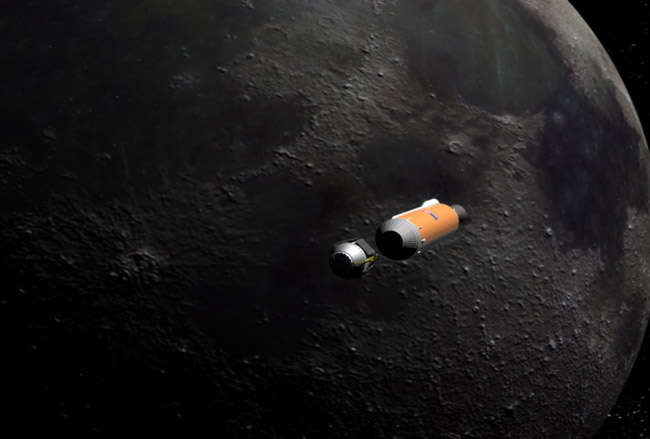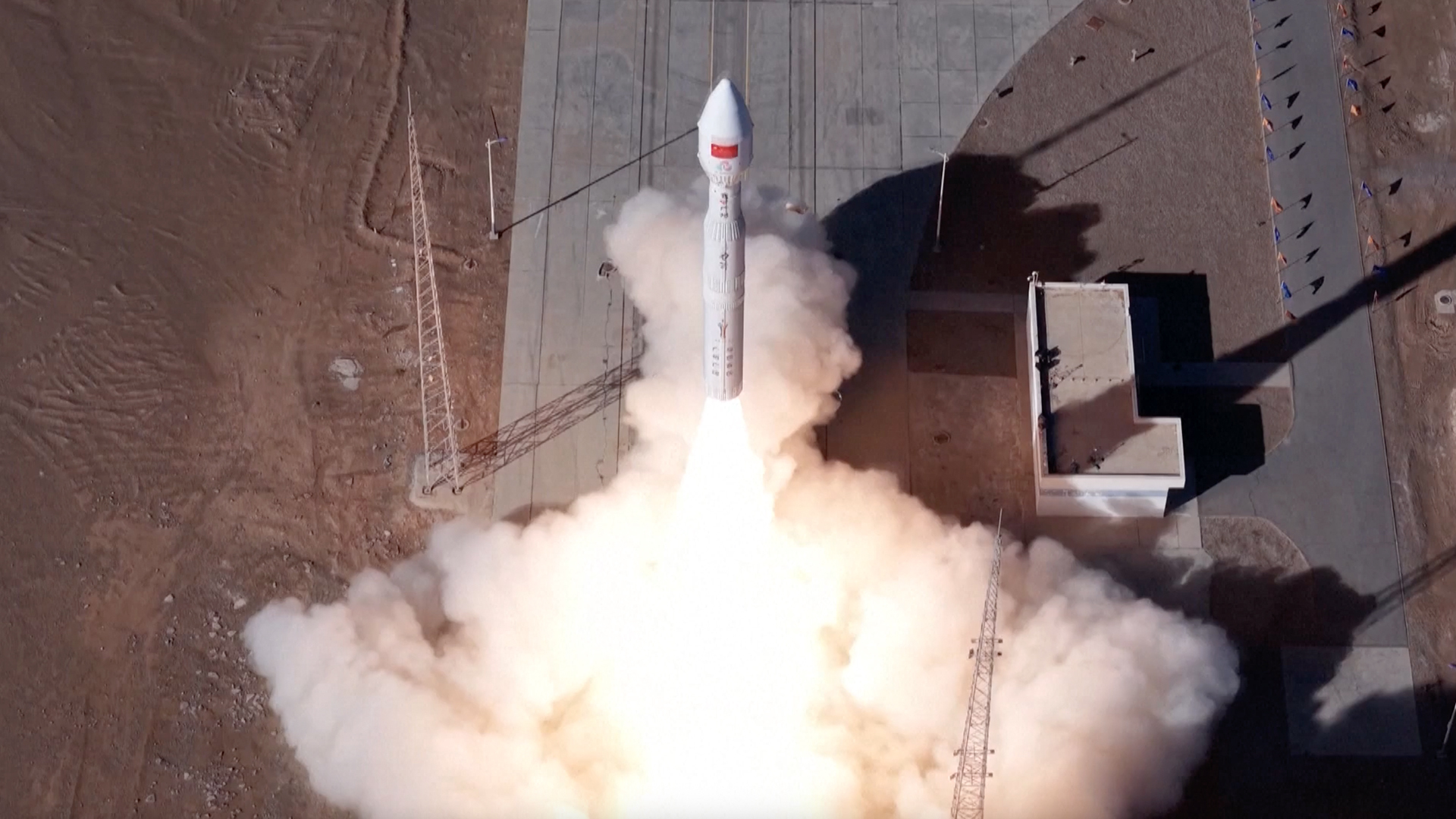NASA Adds Moon Crashing Probes to LRO Mission

NASA's nextmission to Moon will not merely orbit the gray satellite, but crash twovehicles into its South Pole to hunt for water ice, the space agency saidMonday.
In additionto mapping the Moon to support future astronautmissions, NASA's LunarReconnaissance Orbiter (LRO) spaceflight will also aim a spent fuelstage and impactor probe at a southern crater rich in hydrogen and, possibly,ice.
"I thinkaggressively touching the Moon is an understatement," said Scott Horowitz,NASA's associate administrator for the Exploration Systems Mission Directorate,in a Monday press conference. "What this mission buys is an early attempt toknow what some of the resources we're going to have...we know for sure that forhuman exploration to succeed we're going to have to essentially liveoff the land."
Astronomersknow that hydrogen exists in some form on the permanently-shadowed craterfloors along the Moon's polar regions from past lunarorbiters. The Pentagon's Clementine spacecraft hinted at water ice in acrater called Shackleton in 1994, while NASA's Lunar Prospector unmistakablesigns of hydrogen on the Moon's surface.
NASA hopesits LRO and crash missions will provide solid answers on the presence water iceon the Moon, and whether it exists in forms that may prove useful for futureastronauts. Under the space agency's exploration vision, a four-astronaut Moonmission is slated for nolater than 2020.
Lunarsmash-up
Set tolaunch with LRO in October 2008, the $73 million Lunar Crater Observation andSensing Satellite (LCROSS) is a bare-bones spacecraft designed to use camerasand spectrometers to watch its 4,409-pound (2,000-kilogram) upper stage slaminto hydrogen-rich ShackletonCrater, mission managers said.
Breaking space news, the latest updates on rocket launches, skywatching events and more!
"It's gotthe mass of an SUV and we'll send it into the South Pole of the Moon," LCROSSproject manager Daniel Andrews, of NASA's Ames Research Center, said of theupper stage. "We will create a substantial plume [and] excavate some samplematerial, some of which we think will be water ice."
The1,940-pound (880-kilogram) LCROSS probe will fly through the resulting plumeand use its instruments to scan for water while taking photographs, then - 15minutes after the upper stage booster's impact - the "shepherding" satellitewill also crash into the crater floor, Andrews said.
"We know thatwe can steer it sufficiently to sample another region of the crater," Andrewssaid, adding that smashing into the same place twice would likely not yieldadditional valuable data.
A networkof ground-based observatories will observe the impact and plume from Earthwhile LRO, India's Chandrayaan-1lunar orbiter and other spacecraft examine the Moon crash from theirrespective locations, LCROSS mission managers said.
Impactscience
Slammingwater-sniffing probes into objects is no strange feat for NASA.
The spaceagency crashedits Impactor probe into the comet Tempel 1on July 4, 2005 while its parent Flyby craft and other space and ground-basedobservers looked on during the DeepImpact mission. NASA's Lunar Prospector orbiter also crashedinto the Moon in July 1999, also in the hope of stirring up water ice, thoughresearchers believe it may have hit at too shallow an angle to do much science.
"The modelsshow that it kicked up a lot of material but mostly skidded on the surface,"said Butler Hine, NASA's Robotic Lunar Exploration Program manager, of theearlier Moon crash.
Europe's SMART-1orbiter - currently circling the Moon - is also expected to crash intothe lunar surface later this year.
But LCROSSmission managers expect their crash-destined duo to carve a Moon crater 16 feet(4.8 meters) deep, about 100 feet (30 meters) wide and toss up about2.2-million pounds (1,000 metric tons) of lunar material.
That'senough lunar material to fill 10 space shuttle payload bays to the brim,Andrews said, adding that the plume could reach up to 40 miles (64 kilometers)above the lunar surface.
Lunarpiggyback ride
The LCROSSmission is a lateadd-on to NASA's LRO mission.
Horowitz saidthe secondary payload became possible when NASA decided to switch to a largerrocket booster to allow extra safety and design margin for LRO.
LCROSS waschosen after a brief competition among 19 contenders, each of which wererestrained by a 2,204-pounds (1,000-kilogram) spacecraft weight cap and a costof no more than $80 million.
NASAfinally chose LCROSS out of four finalists, which included a similar Moonimpact proposal that did not make use of the rocket's upper stage, an orbitalmicrosatellite and a small, hopping lunar lander, Horowitz said.
The key toLCROSS lies in its Moon crashing fate. Unlike LRO, which is expected togenerate extremely detailed maps, the LCROSS effort will actually bite into thelunar surface at a speed of 5,592 miles per hour (or about 2.5 kilometers persecond).
"You neverquite know what's there for sure until you touch it," said Hine of the Moon'ssurface. "And once we get the answer to that, it will help us plan outfuture human missions."
- NASA Considers Stowaway Finalists for LRO Launch
- Lunar Reconnaissance Orbiter: Searching For A 'New Moon'
- Moon Water: A Trickle of Data and a Flood of Questions
- Target Moon: World Space Agencies Detail Lunar Plans

Tariq is the award-winning Editor-in-Chief of Space.com and joined the team in 2001. He covers human spaceflight, as well as skywatching and entertainment. He became Space.com's Editor-in-Chief in 2019. Before joining Space.com, Tariq was a staff reporter for The Los Angeles Times covering education and city beats in La Habra, Fullerton and Huntington Beach. He's a recipient of the 2022 Harry Kolcum Award for excellence in space reporting and the 2025 Space Pioneer Award from the National Space Society. He is an Eagle Scout and Space Camp alum with journalism degrees from the USC and NYU. You can find Tariq at Space.com and as the co-host to the This Week In Space podcast on the TWiT network. To see his latest project, you can follow Tariq on Twitter @tariqjmalik.
